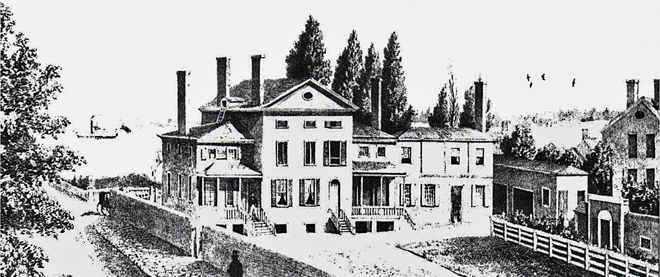War of 1812: Did the Americans throw the fight?
A provocative author says a wealthy businessman paid the U.S. to abandon a winning strategy
Frederic Remington Art Museum, Ogdensburg, NY
Share

An American victory over Canada in the War of 1812 should have been dead simple. Besides a huge advantage in manpower and resources, the United States Army also enjoyed the benefit of an obvious winning strategy. “The St. Lawrence River was the lifeline for the entire British force in North America,” recounts Maj. John R. Grodzinski, history professor at the Royal Military College in Kingston, Ont. “Every regular soldier in Upper Canada, every musket, artillery piece and shot plus most of their food and communications moved along that river.” American control of the St. Lawrence would have instantly starved the colony of men, supplies and information. After that, victory was inevitable.
And yet the American army never put such a strategy into effect. Instead of quickly going for the jugular, it spent most of its time and effort on the bloody hinterlands of the Canadian frontier, in places like Niagara Falls and other areas in southwestern Ontario; the St. Lawrence was left in British hands. Why?
Hidden away in U.S. historian Alan Taylor’s 2010 book The Civil War of 1812 is a provocative, if ultimately unproven, explanation for America’s reluctance to pursue this winning strategy: Washington was paid to throw the war.
If money, rather than tactics or patriotism, was behind the British victory then it’s not those familiar heroes such as Sir Isaac Brock, Tecumseh or Laura Secord we should be celebrating during the 200th anniversary of the War of 1812. Rather it’s David Parish, a German-born financier and upstate New York landowner, who deserves credit as the real saviour of Canada.
“One of the most important reasons why the Americans frittered away their forces on marginal theatres during the War of 1812 is the political clout of Parish, one of the richest men in America at the time,” says Taylor. Parish settled in Ogdensburg, N.Y., on the south shore of the St. Lawrence in 1808 after making his fortune arranging a massive shipment of gold and silver bullion from Mexico to Napoleon’s France. His plan was to turn Ogdensburg into a booming metropolis modelled after his hometown of Hamburg, Germany, and he built roads, mills, stores and factories to attract settlers. Before the war, the area’s primary business was selling food to British troops in Prescott, Ont. “Both sides of the river benefited from this commerce and were appalled at the thought of war,” says Ed LaVarnway, executive director of the Frederic Remington Art Museum in Ogdensburg, and a local historian well-versed in the era.
The arrival of war saw Ogdensburg’s lucrative trading business disrupted by a series of tit-for-tat cross-river raids. Parish, a savvy political operative with connections among both the British and U.S. leadership, sought to protect his investment by moving this bothersome war as far away as possible. “As long as we are not annoyed by the presence of American troops,” Parish wrote, “I apprehend no danger.” But how to get the two armies to leave such a crucial battle zone alone?
As the war dragged into 1813, the U.S. government soon found itself facing a financial crisis, and in need of Parish’s aid. The bulk of federal revenues came from customs duties, which soon dried up due to a successful British naval blockade of the Atlantic seaboard. A helpful Parish arranged a crucial $16-million bond deal that allowed Washington to pay its bills. But as quid pro quo for the bond issue, Taylor argues, Parish demanded the U.S. military abandon the St. Lawrence Valley. “I believe this is the reason they insisted on fighting the war in places they could not win,” he says.
Would the U.S. government really agree to abandon a winning strategy in exchange for $16 million? “There is no smoking gun,” the historian admits. “This is a circumstantial case.” He bolsters his argument with letters from British officers describing their tacit understanding with Parish’s agents that American soldiers would avoid the area and the British would refrain from provocative attacks. Taylor also points out the transfer of funds coincides with a U.S. military withdrawal from the area.
The lone incursion by American forces into the St. Lawrence Valley after the bond deal, a campaign that culminated in a British victory at Crysler’s Farm in late 1813, is the exception that proves his rule, says Taylor. The U.S. commander had orders to attack Kingston but decided instead to head downriver. “The whole operation was thoroughly botched and ended in utter failure,” he notes. “And it was never repeated.”
Ogdensburg’s LaVarnway, whose museum is located in Parish’s old mansion, favours this controversial payoff theory. “I find Taylor’s thesis to be highly plausible,” he says. “It fits with what I have seen of Parish’s correspondence. He was a businessman, first and foremost.”
Not everyone is convinced. Military historian Grodzinski explains the mystery of the St. Lawrence Valley in more practical terms. “Events along the river are suggestive of the general lack of resolve throughout the United States toward the war” rather than the mark of any one man’s efforts, he says. “This was a very complex conflict.” Grodzinski also notes that, late in the war, American high command actually drew up plans to flood the St. Lawrence Valley with 20,000 men in a full-on assault against the British colony’s central nervous system. Either Parish’s influence had waned by then, or it simply took the Americans that long to get down to business. Regardless, the plan was abandoned once a peace treaty was ratified in 1815.
As for Parish, perhaps Canada’s greatest ally in the war, his grand vision for Ogdensburg was never fulfilled. He lost his fortune in an Austrian bank fraud and drowned himself in the Danube River in 1826.